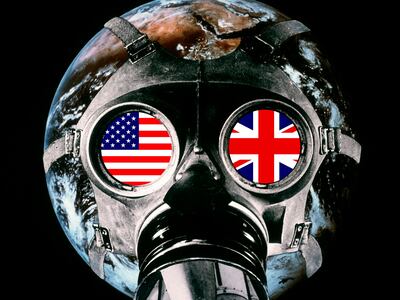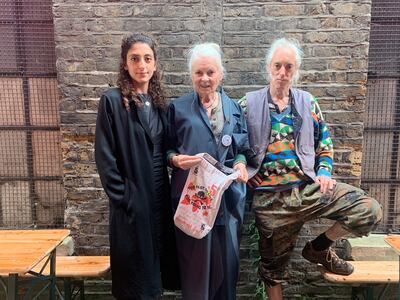As part of a co-ordinated day of protests, on February 15, 2003, millions of people worldwide took to the streets to demonstrate against the US coalition’s bombing campaign of Iraq. Among the record one million protesters in London was a little-known street artist.
Using stencils and cut-up pieces of brown cardboard, he created placards for the event: a little girl hugging a gravity bomb as if it were her doll, the word "No" emblazoned across her forehead; a bright yellow bow upon a military helicopter, with the tagline "Wrong War" underneath; a yellow smiley face hidden under the Grim Reaper's hood as he holds out his bony fingers.
The artist gave the placards to his friends and asked them to distribute them in the march. Afterwards, many were confiscated by the Metropolitan Police. Others wound up on the street, crumpled and stepped on. A few made it back to his studio. But since then, they have become sought after and now command many thousands of pounds because their maker has become the famous Banksy.
A full set of the three original placards are now on show, alongside some 90 other works, in No – 20 Years of Stop the War: A Visual Retrospective, at the Nunnery Gallery in London. The exhibition brings together art made for the Stop the War Coalition, which was launched after the 9/11 attacks and is the main organiser of anti-war demonstrations in the UK.

“Street art and political protests are very much intertwined,” says Zayna Al-Saleh, who curated the London exhibition with Chris Nineham, Mayer Wakefield and Terina Hine of Stop the War Coalition. “This is a moment to bridge activism with art in a direct and explicit way. I don't think that happens enough in the art world. We tiptoe around the two things, but with this exhibition art and activism are constantly in dialogue.”
The works are varied, from the documentation of the protests by photographers such as Jess Hurd, Guy Smallman and Steve Eason to works that use the marches as a staging ground. Other pieces reveal a lineage of political art in the UK, such as the work of Peter Kennard, who adapted a photomontage criticising the arms race of the Cold War – a gas mask with US and Soviet flags – to protest against the US-UK coalition in Iraq.
The high-profile names involved with Stop the War Coalition, which organised the 2003 march, shows its cultural reach. Musician Brian Eno has been the group's president since 2007. He contributes a previously unpublished sound piece to the exhibition, while fashion designer Katharine Hamnett shows her text-based protest T-shirts. Dame Vivienne Westwood has donated a limited-edition print, based on a satirical cartoon that evokes a flatulent Donald Trump-Boris Johnson hybrid, which she created to oppose the former president’s 2019 visit to the UK.

The Stop the War Coalition has a long-standing relationship with Middle Eastern countries, organising numerous protests in responses to conflicts in Palestine, Syria, Iraq and elsewhere.
At the exhibition’s opening, a surprise addition of a work was unveiled: a video commemorating the late Tony Benn, a labour leader and supporter of the coalition. It shows Palestinian artist Taqi Spateen spray-painting a quote by Benn on to the wall separating Israel and Palestine, near Bethlehem. Spateen made the work as a gift from the people of Palestine to the Stop the War Coalition, in recognition of the organisation's support for their cause.
“It’s interesting to have a role reversal,” says Al-Saleh, who is Palestinian and grew up in the UK. “You have the country that is usually seen as oppressed, and they're actually showing solidarity with the movement that has shown them solidarity in the past.”
Last summer Spateen also painted a mural of George Floyd, whose murder in Minnesota launched racial injustice protests across the US, on the separation wall, near Banksy’s graffiti.
Al-Saleh participated in the famous 2003 London protest, aged 12, brought by her mother. She became more actively involved with the movement in 2008, when Stop the War was organising protests against the conflict in Gaza. In her day-job, however, she works as a curator and private dealer..
Stop the War has sustained criticism. The organisation is also aligned with the left wing of the Labour Party, which is often at odds with the party's mainstream. However, this history is mostly absent from the exhibition, which documents the wide range of support that the protest movement has enjoyed among prominent cultural figures.
“People say, ‘protest doesn't solve anything’,” says Al-Saleh. “But I feel that the message does come across. The younger generation are more inclined to be anti-war than the older generation, and we’re starting to reap the results of the hard work of the movement. We had the biggest Palestine protests ever recorded in British history only a few months ago, with some 200,000 people attending.”
“With this exhibition, we're honouring the millions of people that attended the protests. But it's also a thank you to the artists.”
No – 20 Years of Stop the War: A Visual Retrospective is at the Nunnery Gallery, London, until Sunday, September 19





